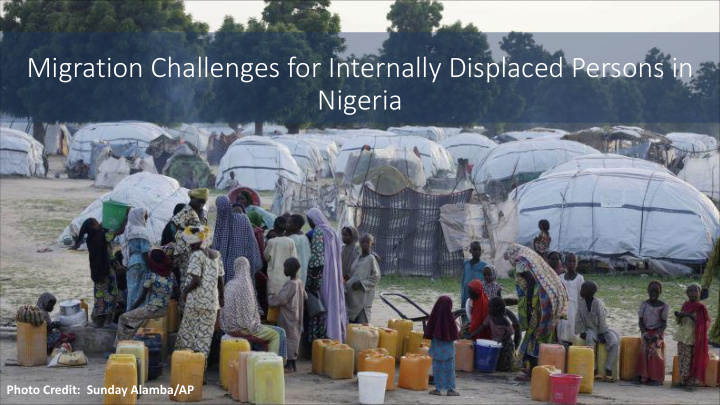



Migration Challenges for Internally Displaced Persons in Nigeria Photo Credit: Sunday Alamba/AP
Assessing Resettlement Options for Displaced Persons in North-East Nigeria Okechukwu Ikeanyibe - Senior Lecturer, Department of Public Administration and Local Government, University of Nigeria, Nsukka, Nigeria (okey.ikeanyibe@unn.edu.ng) Rosaline G. Agiamoh - Graduate Student (PhD), Department of Management & Public Administration, Higher School of Economics, National Research University, Moscow - Russia (ragiamoh@hse.ru)
Introduction -IDPs in Nigeria • Over 2.3 Million people have been displaced in Nigeria since 2009 (UNHCR 2017) • The cause of displacement is largely due to sectoral violence by the terrorist group 'Boko Haram' (An Islamist sect formerly known as Jamā'at Ahl as-Sunnah lid-Da'wah wa'l-Jihād) ranked as the world's deadliest terror group by the Global Terrorism Index in 2015 • The North-Eastern part of Nigeria is the most affected region • There has been continuous insecurity across North-East Nigeria for over 10 years • The security crisis has triggered forced migration to cross-border countries • A large number of Nigerians have also fled the continent and are seeking asylum in UK, Europe and USA.
Source: www.internal-displacement.org
Source: UNHCR 2017
Condition of IDPs in Camps and Non-Camp Conditions in North-East Nigeria • Causes of displacement in Nigeria largely due to: • Natural disasters, environmental degradation and climate change (floods, rising sea levels, oil spills) • Communual & ethno-religious conflict (Riots in Kano and Kaduna in the 90's) • Political Violence (election violence) • Boko Haram Insurgency in the North-East which is by far the greatest trigger of displacement in the country • The Nigerian government has had challenges managing the volume of displaced persons which in comparison exceeds the entire population of some countries (e.g. Estonia, Cyprus and Bahrain all have populations below 2 million). • Across some states public schools were converted into temporary camps. • There is still no central administrative database for recording displaced individuals across the country • Camps do not conform to UN standards and thousands live in sub-human conditions with no access to basic services or amenities (Health, Water and Sanitation, Education and Security)
A Framework of Sustainability in the Resettlement of IDPs • Displacement is often treated as an emergency situation • In Nigeria's case the Government responded with NEMA • UN Sustainable Development Goals (SDGs) template is used as guide for immediate humanitarian support by NGOs and Int'l Aid Agencies. _________________________________________________________ • However displacement can be protracted for years (17-20 years) at which point the temporary emergency situation has to transition to a more permanent sustainable development plan. • Cernea’s Impoverishment Risks and Reconstruction (IRR) model developed in the 90s can help articulate requirements for more durable resettlement solutions.
Source: Aboda et al, 2019 (Makerere University, Uganda)
Options for durable solutions in resettlement of Boko Haram displaced persons: An assessment • Integration in Urban communities to avoid stigmatization as opposed to Rural localities • New policy blueprint implementation - similar to post-war reconstruction (e.g. Marshall Plan (1948) or South Africa's Post-apartheid Reconstruction and Development Programme (1994)) • Centrally coordinated flow of aid/donations to support policy blueprint implementation (medication - clinics, nutrition - farms/equipment, trade agreements) • Subsidized Public Infrastructure (Health, Education, Water & Sanitation) • Institution and support of IDP cooperatives • Mass housing projects • Farm land allocation + trade/export contracts • Credit Union - Micro-financing
Poor SDG compliance in IDP Camps Photo Credit: Premium Times Nigeria
Ongoing Military activities in North-East Region Photo Credit: Aljazeera Photo Credit: BBC
Conclusion & Recommendations • Local integration in host communities (preferably urban centres) currently appears to be the most economical and efficient option for the reintegration of IDPs to society. This option also reduces stigmatization and provides greater access to development infrastructure • Vocational Training Programmes should be structured to provide immediate employment for IDP trainees. • The formation of cooperatives within host-communities could help speed up the process of cultural interaction and socio-economic well-being. • The Nigerian government could greatly benefit from a centralized policy document to serve as a blueprint for sustainable socio-economic development for IDPs and those living below the poverty line. Administrative database management and budgetary allocations could help reduce the national poverty index towards meeting the global SDGs.
IDPs and thousands below the poverty line in Nigeria work as scavengers in waste dumps and landfills. They expose themselves daily to health hazards and are potential hosts for environmental pathogens
Waste is sorted by hand without any protective gear. Sorted bales are carried on backs onto lorries which transport them to ports for further compression and export. IDPs interviewed said they received between $1-$3 per day which helped them sustain their families. This motivation outweighed the obvious health risk they continue to face daily.
Waste workers (majority of whom are IDPs) live in shanty conditions on vacant plots right next to waste dumps and landfills. Social segregation is noticeable within these groups evidenced by: Gang/clique set-up based on - Type of waste collected and territory covered.
Recommend
More recommend